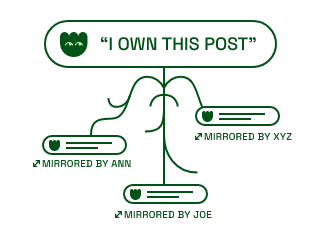Social network goes 3.0

padaw3n
about 1 month ago ·
5 min read

Last May 18, Aave, one of the largest lending platforms, launched a protocol called "Lens Protocol", a permissionless, composable and decentralized social graph that facilitates the creation of a Web3 social platform.
It uses existing concepts of social networks and merges them with new Web3 concepts around ownership by implementing NFTs as a core element of the protocol.
The protocol is open source and allows developers to build their own social platforms on top of it.
What is a social graph?
A social graph is a diagram that illustrates interconnections among people, groups and organizations in a social network. Today all traditional social media like Facebook, Twitter, Instagram are centralized since all of your interactions are hosted in the company’s servers.
So this type of social graph is centralized and private, meaning all users depend on the platform's algorithms and policies and content creators do not truly own anything published on these platforms. There is no portability. Your profile, friends, and content are locked to a specific network and owned by the network operator. If you wanted to leave Facebook today for a competing social network you would need to start building up your social graph from scratch. A herculean task that many are not willing to take upon them.
Lens Protocol corrects this by building a decentralized, non-custodial social graph built on top of the Polygon blockchain that any application can plug into. Rather than being owned by large tech corporations, it is designed to allow creators to own the connections with peers.

How do users own a social graph?
NFTs form a crucial element within the protocol, allowing the social graph to be composable and permissionless. Every post, every follow and every “like” is tokenized as an NFT and it is ownership over this NFT that gives you control of your content. Nearly all content within the protocol thereby also becomes “ownable”.
Thanks to an open social graph owned by the user any application can connect and can build a user interface. Each application using Lens benefits the entire ecosystem in that it contributes towards the further development of the social graph. Creators no longer need to worry about losing their content, audience, and livelihood based on the whims of an individual platform's algorithms and policies.
Concretely, what benefits do end-users get? For example, users can switch from one application to another while keeping their content as well as their subscribers. Lastly and perhaps most importantly, Lens Protocol is fully open source and anyone can build their own apps on top of the protocol.
What features does Lens Protocol have?
Lens has the functions of a traditional social media like having a profile, commenting, resharing a post, and more. Users will own everything, as these key functions are powered by NFTs.

CREATE PROFILE
Profile NFTs are the key element in the protocol. It's ownership over this NFT that gives you control over your content. These dynamic NFTs contain the history of all posts, mirrors, comments, and other content you create. An address can contain multiple profile NFTs, and a profile NFT can even be owned and operated by a DAO through a multisig wallet!

POST / COMMENT / MIRROR
Publications are the lifeblood of the Lens Protocol. Profile owners can publish pictures, music, videos or other content stored on either a decentralized protocol such as IPFS or Arweave, or a centralized storage provider like AWS S3.Publications are posted directly to a user's ProfileNFTs.There are three publication types: Post, Comment and Mirror.
Post is the standard publication type, akin to a regular post on traditional social media platforms. A post is composed of a collection module and a reference module. The collection module contains the logic that allows other users to mint the publication in an NFT. The reference module contains the logic that determines who can comment and mirror the publication.


Comment is a publication type that points back to another publication, whether it be a post, comment or mirror, akin to a regular comment on traditional social media. Like publications, comments live in the user's Profile NFT and therefore are wholly owned by the user. A comment can have a reference module conditions. As comments are linked to a publication they are subject to the original publication's Reference Module conditions. For example a publication may have a referral module that limits comments to only those accounts that follow the author of the original publication.

Mirror is a publication type that points to another publication. It’s like retweeting on twitter. They also are subject to the terms of the original publication's reference module. Like comments a publication can for example have a reference module that limits the mirrors to the accounts that follow the original poster.
FOLLOW / COLLECT
Lens offers two types of Profile Interactions.

Follow NFT – When you follow someone, you’re granted a follow NFT. Each of these NFTs has a unique token ID that comes with innate rarity & utility. Example : The first 1000 followers have one vote each or a profile could attach a follow module that requires a user to pay 5 MATIC to receive a Follow NFT.
These are NFTs with integrated voting and delegation capability. They have built-in governance capabilities, such as vote delegation, to allow for the creation of Social DAOs using Lens Protocol. These unique traits can be used to limit voting to your most loyal fans in governance. Of course, like other NFTs they can also be sold and transferred on an open-market.

**Collect **- Like what you see? You can collect publications from people you follow. A new form of self-expression, curate your collection, and show off what you love. This collect feature enables anyone to collect your content based on the price, size, and time limit you set ! So collects allow creators to monetize their content. Creators can also make their collect modules to add even more functionality!
Lens developer garden:
You can Explore the developer garden where you can learn more about the key features of the protocol and how they work: text
Garden is growing
There are already some application running on lens protocol like:
LensFrens: Discover and follow other lens profiles based on similar Web3 footprint. Lenster: Lenster is a decentralized, and permissionless social media app. Phaver: Share-to-earn decentralized social app for the most interesting feed on your phone Alps Finance: Decentralized social trading network. Build your DeFi investing community and reputation today! Refract: Your crypto-friendly link board. Discover new projects, highlight interesting articles and share new ideas.
Here you can find more apps powered by lens.

Conclusion
Lens Protocol seeks to solve the major problems of existing social networks like centralization of data and missing portability of profiles, followers and content. It takes the basic functionality of a social network but brings in lots of new cool stuff. In particular new ways for creators to monetize content and communities to rally together. Imagine every sub-reddit and every Twitter community was a DAO with native coordination tools at disposal, that’s Lens in a nutshell. Developers also seem to love it. With all these new features Lens protocol has nothing to envy traditional social networks, on the contrary it’s only getting started and has its best days ahead.
Sources:
https://medium.com/@bitsnbyte/lens-protocol-the-decentralized-social-media-platform-73461dd332fe https://tokenizedhq.com/lens-protocol/ https://github.com/aave/lens-protocol https://mirror.xyz/lensprotocol.eth/YG9iFIs2emVFRtj3JqY95Dk6opNqM0aC9YoM-Ppp5as https://docs.lens.xyz/docs

padaw3n
about 1 month ago ·
5 min read
Latest Content
July 2022
Social network goes 3.0
July 2022
Azuro Protocol: Can the betting industry...
April 2022
Polynomial The New DeFi Derivatives Powe...
March 2022
Courtyard: Bringing Billions of Dollars ...
February 2022
The Rise of Music NFTs - Will this unlea...
January 2022
Deep dive into Perpetual Protocol v2
January 2022
Deep dive into Treasure DAO
January 2022
Why you should use Cowswap for all your ...
We are a multi-faceted team of crypto enthusiasts based in Berlin.
© 2021 cryptotesters UG
Products
Cryptocurrency exchanges
Crypto wallet guide
Crypto savings accounts
Defi lending rates
Crypto cards
Exclusive crypto deals
Ethereum staking
Resources
Articles
Reviews
Podcasts
Tutorials